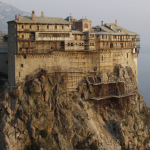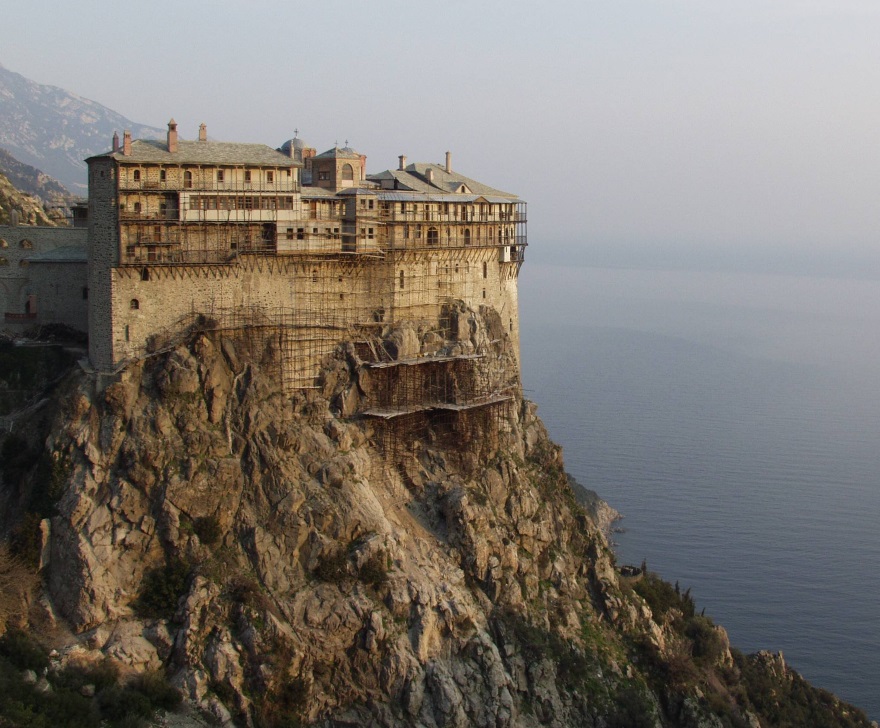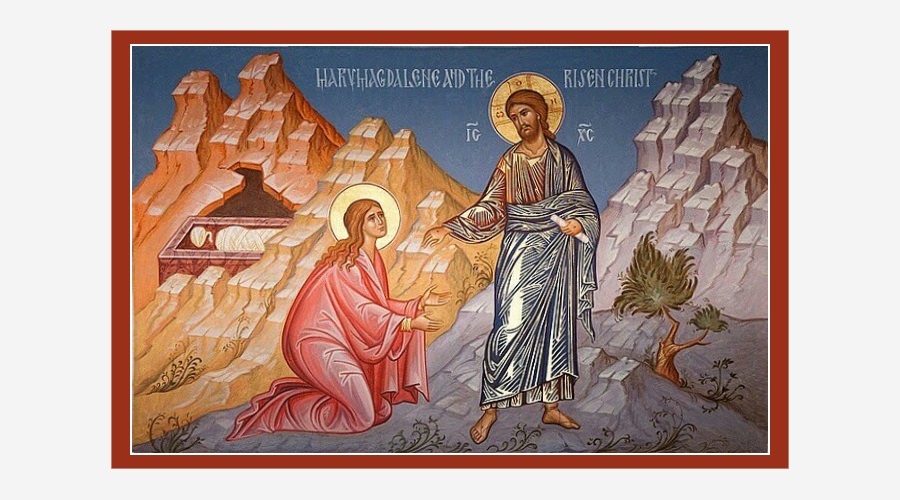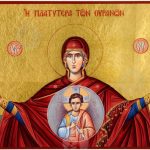Deprecated: trim(): Passing null to parameter #1 ($string) of type string is deprecated in
/home/aoiusa/public_html/wp-content/plugins/sexybookmarks/public.php on line
388
Deprecated: trim(): Passing null to parameter #1 ($string) of type string is deprecated in
/home/aoiusa/public_html/wp-content/plugins/sexybookmarks/public.php on line
394
Deprecated: trim(): Passing null to parameter #1 ($string) of type string is deprecated in
/home/aoiusa/public_html/wp-content/plugins/sexybookmarks/public.php on line
400
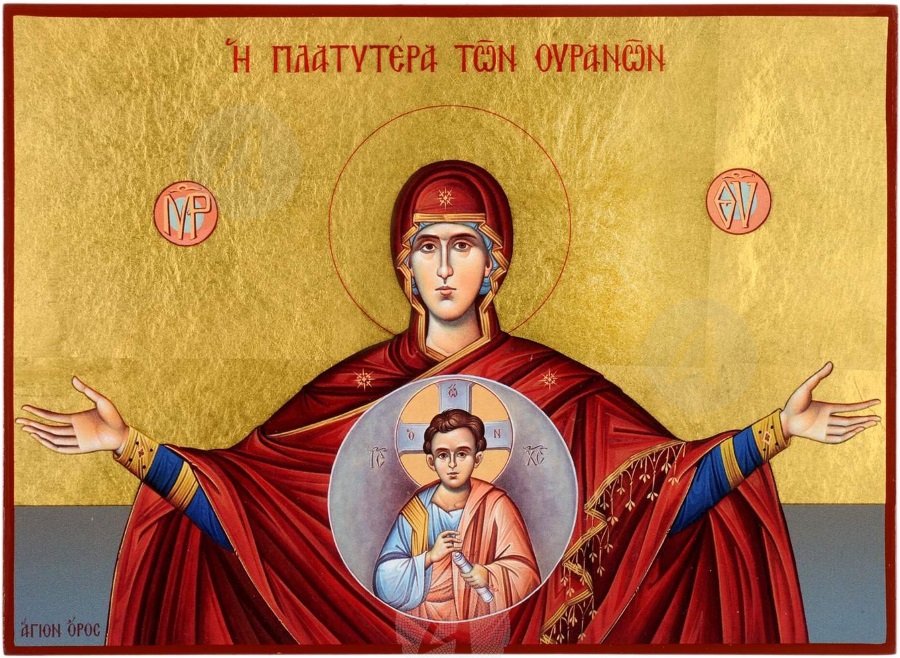
The Theotokos (Virgin Mary) — Wider than the Heavens
By John G. Panagiotou
“Therefore the Lord Himself will give you a sign. Behold, the virgin shall conceive and bear a son, and shall call His name Emmanuel.” (Isaiah 7:14)
The great prophet of God Isaiah prophesied this proclamation of the salvation of God’s creation some eight centuries before the birth of Jesus Christ. At first glance, in the realm of the natural order of things, to read that a virgin birth is even possible is to speak of madness or at the very least statistical improbability. Yet, this Scripture may very well be the most crucial in all of the Old Testament for it summarizes the need of Israel and Judah for a Savior and a Redeemer to stave off their unfaithfulness while offering hope and comfort of a future supernatural event where God would intervene in human history in a way previously unknown in depth and magnitude.
Before we can reflect on this great mystery, let us look at the personage of Isaiah and his historical societal context in the world into which he was living at the time of this prophecy.
Writing in about the eighth century B.C., we are told in the early verses of Scriptures attributed to Isaiah that Isaiah was a Hebrew who lived during the reigns of the Kings of Judah (also known as Zion): Uzziah, Jotham, Ahaz, and Hezekiah (Isaiah 1:1). He was married to a woman that we know only as “the prophetess” (Isaiah 8:3). Most probably she was known as that because she was married to the prophet. They had two sons Shear-jashub which means “a remnant shall return” (Isaiah 7:3) and Maher-Shalal-Hash-Baz which means “spoil quickly, plunder speedily” (Isaiah 8:3). It would be the birth of their second son whom we shall focus upon as an Old Testament type who is a prefiguration of the anti-type Who is the Savior the Lord Jesus Christ.
The great imminent political and military threat of Isaiah’s day was that Assyria was seeking to infiltrate and overcome both Israel and Judah. Isaiah is told by God and placed by Him in a position to give a word to King Ahaz of Judah warning him to be steadfast against forming an alliance with Syria just as Israel which was also known as Ephraim (Isaiah 7:2) had done to secure protection against the Assyrians. (Isaiah 7:3) Isaiah speaks on behalf of God warning Ahaz that to form such an alliance would ultimately lead to Ahaz’s and Judah’s downfall. (Isaiah 7:3-9) We read that King Ahaz due to his lack of faith in God does not submit to the prophet’s request even after he offers him to do for him a sign of which he still refuses to accept even that gesture with feigned humility. (Isaiah 7:11-12) Isaiah then proceeds to chastise Ahaz for his faithlessness. (Isaiah 7:13)
In spite of Ahaz not heeding Isaiah’s warning against an alliance with Syria and Israel and not allowing Isaiah to fulfill an offer of performing a sign, God still gives Ahaz a sign anyway. This is just another example that God does His own thing in His own way during His own timetable. God does this by the birth of Isaiah’s and prophetess’ son Maher-Shalal-Hash-Baz. “Therefore the Lord Himself will give you a sign. Behold, the virgin shall conceive and bear a son, and shall call His name Emmanuel.” (Isaiah 7:14)
The very meaning of Isaiah’s son’s name Maher-Shalal-Hash-Baz “spoil quickly, plunder speadily” should have served enough of a warning to Ahaz. (Isaiah 8:1-3) As a result, God was thus going to use the Assyrians to discipline Ahaz, Jerusalem, and all of Judah (Ephraim) when the Scripture states, “In that day, the Lord will shave with a razor that is hired beyond the River – with the King of Assyria – the head and the hair of the feet, and it will sweep away the beard also.” (Isaiah 7:20)
Consequently, Assyria was to be an instrument of destruction by God in dealing with Judah. The symbol of which was going to Isaiah’s newly-born younger son. In Isaiah 10:5-6, we read, “Ah, Assyria, the rod of my anger; the staff in their hands is my fury! Against a godless nation I send him and against the people of my wrath I command him, to take spoil and seize plunder, and to tread them down like the mire of the streets.” Through this sign act of Isaiah’s son’s birth, the message to Ahaz is that his demise and the demise of Judah draws nigh.
Yet, beyond the type of Isaiah’s younger son, we are offered the hope that God will do something even greater with the remnant of Judah and Israel that will survive the Assyrian destruction. We find a bridge to the future hope in Isaiah’s older son’s name Shear-jashub which means “a remnant shall return” (Isaiah 7:3) The questions remain as to why God would spare a remnant and what would He do with them in the future?
I believe that the Scripture Isaiah 7:14 lends itself to answer these questions with two key words which do not necessarily apply in total within the context of the birth of Isaiah’s son Maher-Shalal-Hash-Baz in the original Hebrew Masoretic text but does have a definite significance in the Septuagint which is the Greek translation of the Old Testament. The Septuagint was written approximately two hundred years before the birth of Christ during the Hasmonean Period. The words are: virgin and Emmanuel.
In the original Hebrew, the word “almah” which means “young woman or maiden” is used whereas the Greek text uses “parthenos” which means “virgin.” Thus, the Hebrew text as such can specifically apply to Isaiah’s son Maher-Shalal-Hash-Baz since he was born through natural conjugal relations whereas the later Greek translation of the text can specifically apply in all its fullest sense to Jesus of Nazareth whose conception was supernatural through an activity of the Holy Spirit on a willing virgin.
The great Reformed Biblical scholar J. Gresham Machen would reflect, “The question, we think, cannot be settled merely by a consideration of the meaning of the Hebrew word ‘almâ.’ It has been urged, indeed, on the one hand that the Hebrew language has a perfectly unmistakable word for ‘virgin,’ betûlâ, and that if ‘virgin’ had been meant that word would have been used. But as a matter of fact there is no place among the seven occurrences of ‘almâ’ in the Old Testament where the word is clearly used of a woman who was not a virgin. It may readily be admitted that ‘almâ’ does not actually indicate virginity, as does ‘betûlâ’; it means rather ‘a young woman of marriageable age.’ But on the other hand one may well doubt, in view of the usage, whether it was a natural word to use of anyone who was not in point of fact a virgin.” [J. Gresham Machen, The Virgin Birth of Christ (New York: Harper, 1930), 288.]
Beyond this, Isaiah’s younger son’s name which we know conjures images of destruction and desolation. Isaiah’s older son’s name Shear-jashub conjures images of hope that a remnant will be spared. “And it will sweep on into Judah, it will overflow and pass on, reaching even to the neck, and its outspread wings will fill the breadth of your land, O Emmanuel.” (Isaiah 8:8) Though these individuals are seen as indicative of God working in history with the Hebrews during their time, they still pale in comparison as to what God is going to do a perfect way in the fullness of time. The serve as imperfect prefigurations to the perfect manifestation which is to come. To be said in neo-Platonic language and metaphor, they are but mere shadows of the realized ideal which is to come. Isaiah himself would refer to this expectation saying, “Then a shoot will spring from the root of Jesse and a branch from his roots will bear fruit.” (Isaiah 11:1-2) It is the difference in seeing some only partially and not with a total view.
St. John Chrysostom in his Fifth Homily on Matthew’s Gospel clarifies this when he writes, “For here he puts the event as a name: and this is customary in Scripture, to substitute the events that take place for names. Therefore, to say, they shall call Him Emmanuel, means nothing else than that they shall see God among men. For He has indeed always been among men, but never so manifestly.” [Translated by George Prevost and revised by M.B. Riddle. From Nicene and Post-Nicene Fathers, First Series, Vol. 10. Edited by Philip Schaff. (Buffalo, NY: Christian Literature Publishing Co., 1888.) Revised and edited for New Advent by Kevin Knight.]
The name Emmanuel literally means “God with us” which gains one a real understanding that the pre-existent Second Person of the Holy Trinity – the Theanthropos (God-man) who is fully divine and fully human – has visited His creation in a unique definitive way. It is in the incarnation and birth of the God-man that we see the full realization and fulfillment of the Messianic promise. As we shall see in the following New Testament Gospel passages, the key to a full understanding of the meaning of Isaiah’s prophecy can only be found through the spectacle lens’ of a Christocentric understanding of this Old Testament verse which sees the Person of Jesus of Nazareth as the antitype to Isaiah’s typological prophecy of the ultimate vision of the future.
In Matthew 1:23, the words of Isaiah 7:14 reappear, “Behold, the virgin shall conceive and bear a son, and they shall call his name Emmanuel.” This verse comes after earlier in the chapter. we are given by Matthew the genealogy of Jesus Christ which makes reference to the facts that he is of the house of David and the root of Jesse. Matthew then proceeds to tell his readers, “Now the birth of Jesus was as follows. After his mother Mary was betrothed to Joseph, before they came together, she was found to be with child of the Holy Spirit.” (Matthew 1:18)
In Luke’s Gospel, in the account of the Annunciation by the Archangel Gabriel to the Virgin Mary, we find further attestation to the virginity of Mary and the incarnation of Christ. We read, “And Mary said to the angel, ‘How will this be, since I am a virgin? And the angel answered her, ‘The Holy Spirit will come upon you and the power of the Most High will overshadow you; therefore the child to be born will be called holy – the Son of God.’” (Luke 1:34-35)
In John’s Gospel we are told, “And the Word became flesh and dwelt among us.” (John 1:14) The importance of this incarnational theology of Christ is so important to John’s understanding of the Godhead and His relationship to creation that he writes this in his later epistle, “By this you know he Spirit of God: every spirit that confesses that Jesus Christ has come in the flesh is from God and every spirit that does not confess Jesus is not from God. This is the spirit of the antichrist which you have heard was coming and now is in the world already.” (I John 4:2-3)
Every heresy in the history of the Church could arguably be stated as having its roots in a wrong understanding of the incarnation. One need only look at examples such as Gnostocism, Arianism, Nestorianism, and Donatism with their attendant warped understanding of the Person of Christ. This was so much so that even as late as the fourth and fifth centuries at the Councils of Nicea, Constantinople, Ephesus, and Chalcedon respectively, the Church had to address such heresies by: a.) canonizing the twenty-seven books which comprise the New Testament to provide a basic manual of doctrine for the Christian faithful; b.) adopting the Nicene Creed as a statement of faith; c.) and proclaiming the Virgin Mary as Theotokos (in Greek, “Birth-Giver of God”) to affirm and uphold sound Christological teaching as affirmed by St. Cyril of Alexandria and the Fathers of the Council of Ephesus. All of these tenets of the “paradosis” (“deposit of faith”) as the Apostle Paul instructs Timothy “to guard which was entrusted to him” (II Timothy 1:14) form the pillars of what we call orthodox Christian theology.
In other Patristic writings, St. Gregory of Nyssa (335-395 A.D.) would refer to the Prophet Isaiah as one who “knew more perfectly than all others the mystery of the religion of the Gospel”. [“Isaiah 1-39” in Ancient Christian Commentary on Scripture: Old Testament, Volume X, 10th edition; editor Steven A. McKinnon]. St. Jerome (342-420 A.D.) would write of Isaiah, “He was more of an evangelist than a prophet, because he described all of the mysteries of the Church of Christ so vividly that you would assume he was not prophesying about the future, but rather was composing a history of past events.” [“Prophet Isaiah” in The Lives of the Holy Prophets, Holy Apostles Convent, ISBN 0-944359-12-4, page 101]
All of the above we first hear of from Isaiah’s prophecy. Chrysostom reminds us, “For the mouth indeed was Isaiah’s, but the oracle was wafted from above.” [St. John Chrysostom, Homily V on Matthew 1:25, 23.] In the Person of Jesus and only the Person of Jesus do we see the full realization of Isaiah’s Messianic hope.
You may ask — what is the relevance and what are the implications for contemporary Christians today of the fulfillment of Isaiah’s prophecy two thousand years ago? I would say that the relevance and importance can be found in three key distinct points for the believer of today.
First, they show that God works in history. He has not ever abandoned us though we as people may have abandoned Him time and time again. He is not disinterested in us. He is faithful to us just as He was faithful to Israel and Judah. He may use bad circumstances and even our enemies (the Assyrians of our life) to bring us to repentance with the hope of us drawing near to Him. Yet, time and time again history has the thumbprint of the Creator stamped all over it.
Second, having and maintaining a sound, correct theological doctrine of the incarnation is absolutely essential for it to be called Christian theology. The virgin conception and birth of Jesus is a non-negotiable of Christian Faith. Either Jesus is God and His birth was supernatural or else we live in delusion adrift amidst a sea of falsehoods. As St. Athanasius the Great writes, “He took our body, and not only so, but He took it directly from a spotless, stainless virgin without the agency of human father – a pure body, untainted by intercourse with man.” [St. Athanasius the Great in chapter 2 of his work On the Incarnation (St. Vladimir’s Seminary Press)]
Third, the mystery of salvation is the ultimate expression of God’s love for His creation. As the Ark of the Covenant was an imperfect typological prefiguration of the Presence of God among His creation, the perfect fulfillment of the Presence of God amidst His creation came in the virgin womb of Mary thus she becomes a new Ark of the Covenant and a new Tabernacle of God. As Athanasius and other Church Fathers have marveled at the mystery of how God’s creature Mary contained in her womb her uncontainable Creator. Let us look at how the marvel of this has found expression in the ancient hymns of the Church. Only God can do such things! He did not need to go and do all of this for us. He did so because of His great love for His entire creation.
Within the early hymns of the Byzantine Church which chronicle the theology of the people of God at worship, we read inspired references to all of these things. In the Akathist Hymn which dates as early as the sixth century A.D., we in various stanzas of it’s composed poetic hymnography we find the following: “the Archangel hastened into Joseph’s abode and spoke to the Holy Virgin. He Who bowed the Heavens with His descending, is wholly contained, yet unchanged in You. And seeing Him taking the likeness of a servant in your womb, I stand in amazement and cry to you: Alleluia.” (stanza 1); “Beholding herself in purity, the holy one courageously said to Gabriel: Your strange voice seems almost unbelieveable to my soul; for how do you speak of birth-giving without seed?” (stanza 2); “Seeking to know the incomprehensible knowledge, the Virgin cried to him who ministered to her: How may a Son be born from a virginal womb?” (stanza 3); and “The power of the Most High then overshadowed the Virgin, that she might conceive; and her fruitful womb He mad a fertile meadow for all those desiring to reap salvation.” (stanza 4)
If we subscribe to the ancient liturgical axiom, lex orandi, lex credendi (“the law of praying is the law of believing”) [Patrologia Latina, 51, 209-10], then what the Church prays and sings, the Church believes. It becomes clearly evident what Church has believed on this matter since it’s earliest days.
It is also interesting to note and no coincidence at all that in Patristic literature the Holy Sprit is often referred to in technical terms simply as “Panagio” (“the All-Holy One” masculine form using the omega ending) and the Virgin Mary as “Panagia” (“the All-Holy One” feminine form using the alpha ending). If you just look at their ending vowel letters, you get alpha and omega. The Church Fathers Basil the Great, John Chrysostom, Gregory (of Nazianzus) the Theologian, and Gregory of Nyssa to name a few all believed in the virgin birth of the Savior. [see St. Basil the Great, On the Holy Spirit, St. Vladmir’s Seminary Press]
So, there you have it brethren, such is our faith. We serve a big God beyond our comprehension and loves us in such deep ways beyond our comprehension, even to the point of sending His Only-Begotten Son to be nailed to a tree and die for us in the flesh. We in turn are called to turn to Him, trust Him, repent of our sins, and follow Him. In the words of John the Baptist, “Repent for the kingdom of heaven is at hand.” (Matthew 3:2)
I close with yet another hymn of the Eastern Church which summarizes nicely the theology articulated above. It is chanted at every wedding and ordination. “Rejoice and dance, O Isaiah! The Virgin is with child, and shall bear a son Emmanuel, both God and man, and Orient is His Name, Whom magnifying we call the Virgin blessed.” [The Priest’s Euchologion of the Eastern Orthodox Christian Church]
John G. Panagiotou is an Orthodox Christian theologian and writer who is a graduate of Wheeling Jesuit University and St. Vladimir’s Orthodox Theological Seminary. Panagiotou is Professor of New Testament Greek at Cummins Theological Seminary and is a doctoral candidate at Erskine Theological Seminary.
